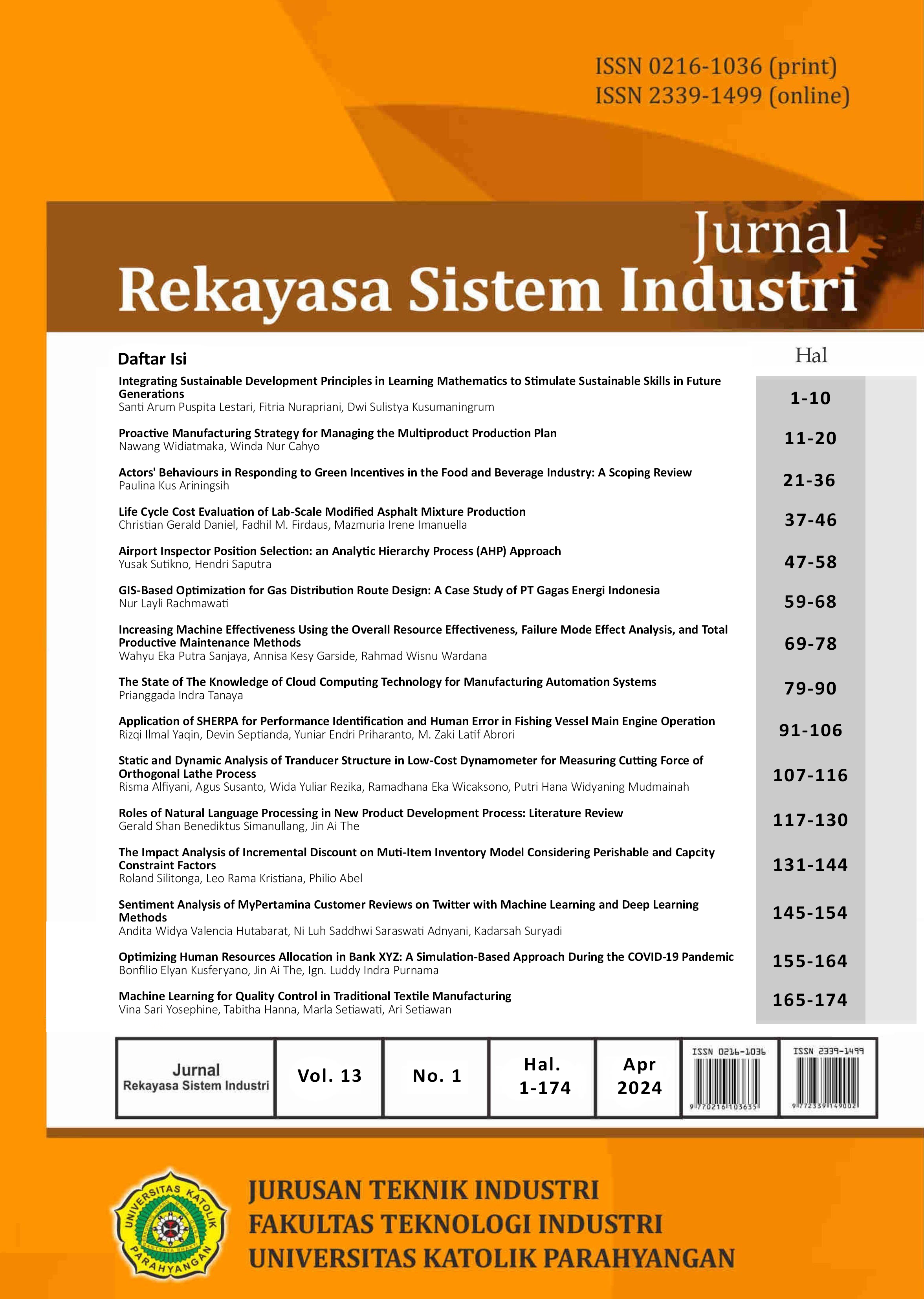Increasing Machine Effectiveness Using the Overall Resource Effectiveness, Failure Mode Effect Analysis, and Total Productive Maintenance Methods
DOI:
https://doi.org/10.26593/jrsi.v13i1.6520.69-78Keywords:
maintenance, overall resource effectiveness, losses, failure mode effect analysis, total productive maintenanceAbstract
PT XYZ is a company engaged in the wood industry which is marketed for export. In carrying out the production process losses often occur in multi drill machines thereby reducing the effectiveness of the machine. These losses arise because the machine is often adjusted and experiences breakdowns. Therefore, this study will analyze the effectiveness of the multi drill machine using the Overall Resource Effectiveness (ORE) method. Furthermore, fishbone diagrams, Failure Mode Effect Analysis (FMEA), and Total Productive Maintenance will be used as a method for providing improvement suggestions to increase machine effectiveness. From the calculation results, the ORE value is 59.58% (below the standard, which is 85%). Furthermore, by using the fishbone and FMEA methods, 3 failure modes with the largest RPN values were taken. Proposed improvements to increase the effectiveness of multi-bore machines are the application of autonomous maintenance, quality maintenance, preventive maintenance, and provision of safety stock.
References
Agustiady, T. K., & Cudney, E. A. (2018). Total Productive Maintenance. Total Quality Management & Business Excellence, 1–8. https://doi.org/https://doi.org/10.1080/14783363.2018.1438843
Ahlaq, M. A. S., Cahyadi, D., & Handika, F. S. (2017). Analisa Perawatan Mesin Pulper Menggunakan Metode Overall Equipment Effectiveness (OEE). INTECH Teknik Industri Universitas Serang Raya, 3(2), 49–54.
Atmaji, F. T. D., & Ngurah, A. A. (2018). Kebijakan Persediaan Suku Cadang di PT ABC Menggunakan Metode RCS (Reliability Centered Spares). Jurnal Manajemen Industri dan Logistik (JMIL), 2(1), 90–102.
Coccia, M. (2018). The Fishbone Diagram to Identify, Systematize and Analyze the Sources of General Purpose Technologies. Journal of Social and Administrative Sciences, 4(4), 291–303.
Dharma, F. P., Ikatrinasari, Z. F., Purba, H. H., & Ayu, W. (2019). Reducing Non Conformance Quality of Yarn Using Pareto Principles and Fishbone Diagram in Textile Industry. IOP Conference Series: Materials Science and Engineering, 508(1), 12092.
Eswaramurthi, K. G., & Mohanram, P. V. (2013). Improvement of Manufacturing Performance Measurement System and Evaluation of Overall Resource Effectiveness (ORE). American Journal of Applied Sciences, 10(2), 131–138.
Garza-Reyes, J. A. (2015). From Measuring Overall Equipment Effectiveness (OEE) to Overall Resource Effectiveness (ORE). Journal of Quality in Maintenance Engineering, 21(4), 506–527.
Hasanah, T. U., Wulansari, T., Putra, T., & Fauzi, M. (2020). Penerapan Lean Manufacturing dengan Metode Takt Time dan FMEA untuk Mengidentifikasi Waste pada Proses Produksi Steril di Industri Farmasi. JRSI (Jurnal Rekayasa Sistem Dan Industri), 7(02), 88–94.
Krisnanti, E. D., & Garside, A. K. (2022). Penerapan Lean Manufacturing untuk Meminimasi Waste Percetakan Box. INTECH Teknik Industri Universitas Serang Raya, 8(2), 99–108. https://doi.org/https://doi.org/10.30656/intech.v8i2.4780
Lukodono, R. P., Pratikto, P., & Soenoko, R. (2013). Analisis Penerapan Metode RCM dan MVSM untuk Meningkatkan Keandalan Pada Sistem Maintenance (Studi Kasus PG. X). Jurnal Rekayasa Mesin, 4(1), 43–52.
Mendrofa, A. J., & Mulyanto, T. (2020). Analisis Pengukuran Total Efektivitas Mesin Flame Cutting dan Plasma Cutting pada Perusahaan Industri Strategis. Jurnal Ilmiah Industri, 8(3), 172–184.
Ouyang, L., Che, Y., Yan, L., & Park, C. (2022). Multiple Perspectives on Analyzing Risk Factors in FMEA. Computers in Industry, 141, 103712.
Pandey, R., & Sridhar, K. (2019). Evaluating The Performance of Plant by Overall Equipment Effectiveness & Overall Resource Effectiveness: A Case Study. International Research Journal of Engineering and Technology, 6(6), 2656–2663.
Peeters, J. F. W., Basten, R. J. I., & Tinga, T. (2018). Improving Failure Analysis Efficiency By Combining FTA and FMEA in a Recursive Manner. Reliability Engineering & System Safety, 172, 36–44.
Rahman, A., Darwiyanto, E., & Junaedi, D. (2016). Analisis dan Implementasi Sistem Rekomendasi Pemilihan Vendor untuk Pengadaan Alat Menggunakan Metode Technique for Order Preference by Similarity to Ideal Solution (TOPSIS) dan Fuzzy AHP (Studi Kasus: PT Universal Tekno Reksajaya). E-Proceedings of Engineering, 3(2).
Rahman, A., & Perdana, S. (2019). Analisis Produktivitas Mesin Percetakan Perfect Binding Dengan Metode OEE dan FMEA. Jurnal Ilmiah Teknik Industri (Jurnal Keilmuan Teknik dan Manajemen Industri), 7(1), 34–42.
Sunarya, S., Hunusalela, Z. F., & Ruslan, H. (2022). Pengukuran Efektivitas Mesin Menggunakan Metode Overall Equipment Effectiveness, Overall Resource Effectiveness dan Gupta Pada Mesin Injection Molding PT. Neohyolim Platech. Jurnal KaLIBRASI-Karya Lintas Ilmu Bidang Rekayasa Arsitektur, Sipil, Industri, 5(2), 160–170.
Wardani, I. K., Atmaji, F. T. D., & Alhilman, J. (2021). An Autonomous Maintenance Design Based on Overall Resource Effectiveness (ORE) Analysis: A Case Study of Paving Molding Machine. Jurnal Ilmiah Teknik Industri, 20(2), 173–183.
Zulfatri, M. M., Alhilman, J., & Atmaji, F. T. D. (2020). Pengukuran Efektivitas Mesin dengan Menggunakan Metode Overall Equipment Effectiveness (OEE) dan Overall Resource Effectiveness (ORE) Pada Mesin PL1250 di PT XZY. Jurnal Integrasi Sistem Industri, 7(2), 123–131.

